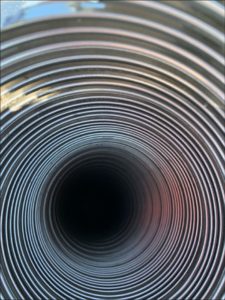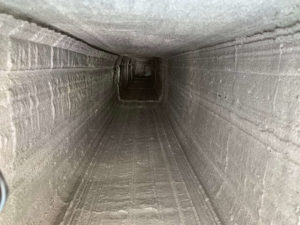Per national fire code, your chimney has to have a complete passageway with no cracks, gaps or separations to expel the flue gases to the outside atmosphere. So when you find out your chimney liner is damaged, you have some decisions to make. The biggest: Should you choose a stainless steel liner or a cerfractory flue liner?
To help with your decision, we’ve put together a little info on the function and best application for each.
 What’s a Stainless Steel Liner & What’s Its Function?
What’s a Stainless Steel Liner & What’s Its Function?
A stainless steel liner is a conduit or an exhaust pipe that expels flue gases through a venting system. Usually, when you’re putting a stainless steel liner in, it’s universally thought of as going in a masonry chimney, but factory-built fireplace also have stainless steel liners. One of the main differences is that factory-built fireplace stainless steel liners are put together in sections like a stovepipe, as opposed to the one long, corrugated piece that’s installed in masonry fireplace systems.
One very important thing to know is that stainless steel is very specific based on the use of the appliance and the flue gases that are being exhausted through it. Stainless steel liners come in different grades of stainless, depending on what fuel you’re burning or exhausting through the liner.
The reason it’s so important that you choose the right one for your system is that different grades of stainless steel have different properties, and the characteristics of the flue gases are totally different depending on the fuel you’re burning.
You see, stainless steel is made kind of like a cake batter. It starts out very generic, like vanilla, but if you want chocolate or strawberry, you have to add different flavorings. In the stainless steel world, these flavorings that you add more of are nickel and titanium, which make the stainless steel more resistant to the corrosive exhaust that comes from burning gas or oil.
So if you have a gas- or oil-burning appliance and you opt for stainless steel, you need to choose a liner with more nickel or titanium.
Here’s a general guide to stainless steel grades based on fuel type and appliance type:
321 or 304 grade stainless is typically used for wood. If you were to mistakenly use one of these with a gas-burning appliance, it would probably only last 2-3 years against the corrosive exhaust.
For gas, you’d want to use a 316-grade stainless steel liner.
Coal is also very acidic, so for these appliances, you have to use a 316 grade or an AL29-4C.
A factory-built fireplace will typically require a stainless steel liner with a lower temperature rating (like 1700 degrees) than a masonry system (which needs to be temperature rated for 2100-2200 degrees).
A Quick Guide to Stainless Steel Liner Installation
When installing a stainless steel liner in a masonry chimney for a fireplace, you almost always have to remove the existing terra cotta liner and install and insulate the new stainless steel liner. Typically, the manufacturer and national fire codes require 1-inch of insulation all the way around, but it will vary depending on the installation guidelines of the liner manufacturer.
When installing a stainless steel liner for a factory-built fireplace, the liner will typically be either solid-packed or air-insulated. If it’s an air-insulated chimney, you’ll have a stainless steel inside flue or exhaust pipe, and then you’ll have an air gap of usually an inch or two. Then, on the outside you’ll have another metal pipe (which could be stainless, but will most likely be galvanized unless it’s for total exposure on the outside of your home).
The way these air-insulated chimneys work is through a siphoning system. As the flue gases rise through the center column and expel to the outside, it creates a draft, which creates airflow between the inner and outer space, and gives you your “air-cooled chimney.” So it’s like a cool breeze blowing between the two liners.
 What is a Cerfractory Flue Liner & What’s Its Purpose
What is a Cerfractory Flue Liner & What’s Its Purpose
A cerfractory flue liner is a two-coat system that restores terra cotta flue liners that have minor damage. It’s a great cure-all for many of your common masonry chimney defects.
For example, if you have a cracked flue liner or missing mortar joints, then we’re able to fill those imperfections with two coatings of material rather than installing a whole new liner. The first coat goes on and fills the imperfections, the second coat gives you a semi-smooth parge coating over it, similar to stucco on a wall, only a lot smoother. When we’re done applying it, it looks a bit like a sprayed-on pickup truck bed liner (like a Rhino liner or a Line-X) — a semi-smooth coating.
Our go-to is always a cerfractory flue liner if it is a suitable candidate for use, because it is less stress on the home. To install it, you’re going over what’s already there. Unfortunately, to install a stainless steel liner, you typically have to remove the terra cotta flue liner first. The machine that breaks out the liner puts a lot of inertia on the chimney structure, which can transfer to the home or the foundation. Sometimes it’s necessary to do that, but if you don’t have to break out the liner to repair the flue liner, then that’s a better choice because it’s less stress on the home structure.
And because this flue liner system consists of a cerfractory cement, it’s basically a really high-temperature cement that can adhere and take any kind of high heat, whether that’s from a chimney fire or the normal heat of the flue gases flowing to the outside.
It’s a complete sealing system of not only the flue liner, but the smoke chamber as well (if it’s for a fireplace). So it’s one continuous cerfractory sealant, from the damper up into the smoke chamber, the flue liner, all the way up to the chimney cap.
That continuous passageway acts as a great funnel and exhaust pipe to get the flue gases out of the chimney as quickly as possible, which is what you’re trying to do. It lowers your resident time, which is the time from when the smoke enters the system to when it exits. In a perfect world you want that to be as close to zero as it can be. The quicker your system exhausts, the less you have to worry about soot and creosote buildup, and noxious gases hanging out in your home.
Cerfractory flue liners also come with a lifetime warranty, so if you have minor imperfections in your flue liner, this can be a great option.
Of course, a cerfractory flue liner isn’t always the best option. You would not use a cerfractory flue lining system to repair a factory-built fireplace chimney. That would be a system that would be repaired by either replacing with the manufacturer provided parts or replacing the entire liner to match with the UL listed standard for that manufacturer’s firebox.
Additionally, if you have large gaps, separations, holes, or blown out sections of terra cotta flue tile — from either a very severe chimney fire or maybe a lightning strike — you would be forced to go with a stainless steel liner system.
Some other situations when we may recommend a stainless steel liner over a cerfractory flue liner:
If you’ve removed your furnace system and just have a water heater, or you’ve upgraded your furnace and it vents through a much smaller liner, then a lot of times, the best choice is to drop a smaller liner inside the terra cotta flue and connect it to the new appliance or appliances. That can be a better choice because if you were to put a coating over it, the sizing of the original flue liner could still be too large to adequately vent it. Size is everything in the chimney and venting industry. You don’t want something oversized because the flue gases will slow down. And when they slow down, you either have carbon monoxide potentially leaking through into the home space or if you’re talking about something that has tar-like properties and hydrocarbons (like wood or oil), you get the flue gases sticking to the liner and giving you a buildup. This sizing issue would also negatively impact draft.
If you’re installing a wood stove insert into a fireplace, typically a fireplace flue liner is way too large for that appliance. So, you would put an insulated stainless steel liner through that system and connect it to the stove.
If you had a traumatic event affect your flue — such as a chimney fire, a lightning strike, or a big tree limb strike (during which sections of tile failed and blew out) — then you would be forced to remove the terra cotta flue liner and line it with a stainless steel insulated liner.
So, Which is Better?
Alright, cut to the chase moment: which is better, stainless steel liners or cerfractory flue liners? Answer: Both are equally good.
Like grabbing a hammer out of the toolbox, you choose based on application. If you’re simply hammering a small nail into the wall to hang a picture, you don’t need a sledgehammer. Conversely, if you’re going to drive a spike into a railroad tie that you’re putting around your garden to landscape, a little hammer isn’t going to work — you’re going to need a sledgehammer.
It’s all about picking the right tool for the right job, but both hammers are equally good in the application that they’re being used for. It’s the same with these liners. The best solution depends on your particular situation and system.
